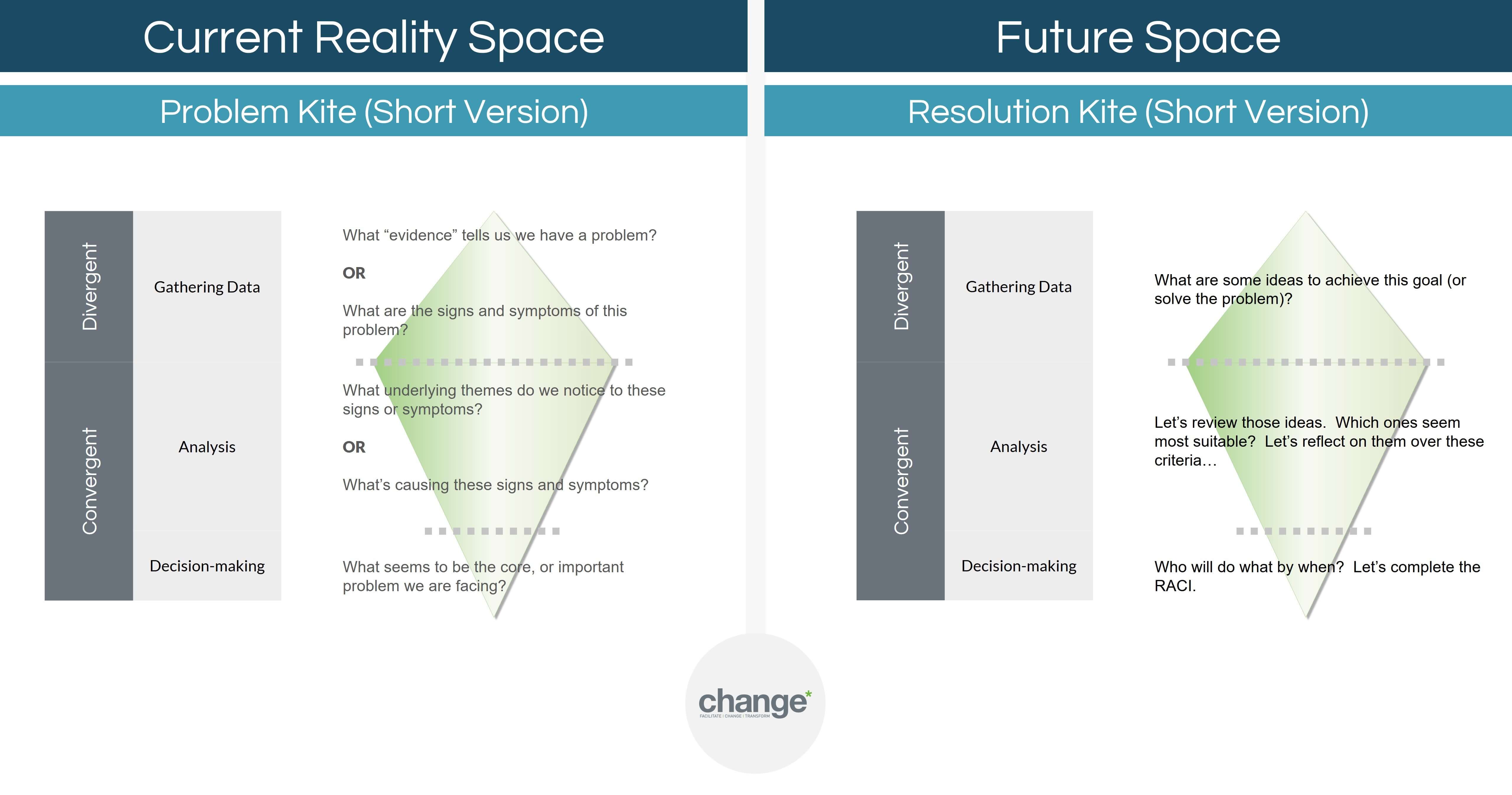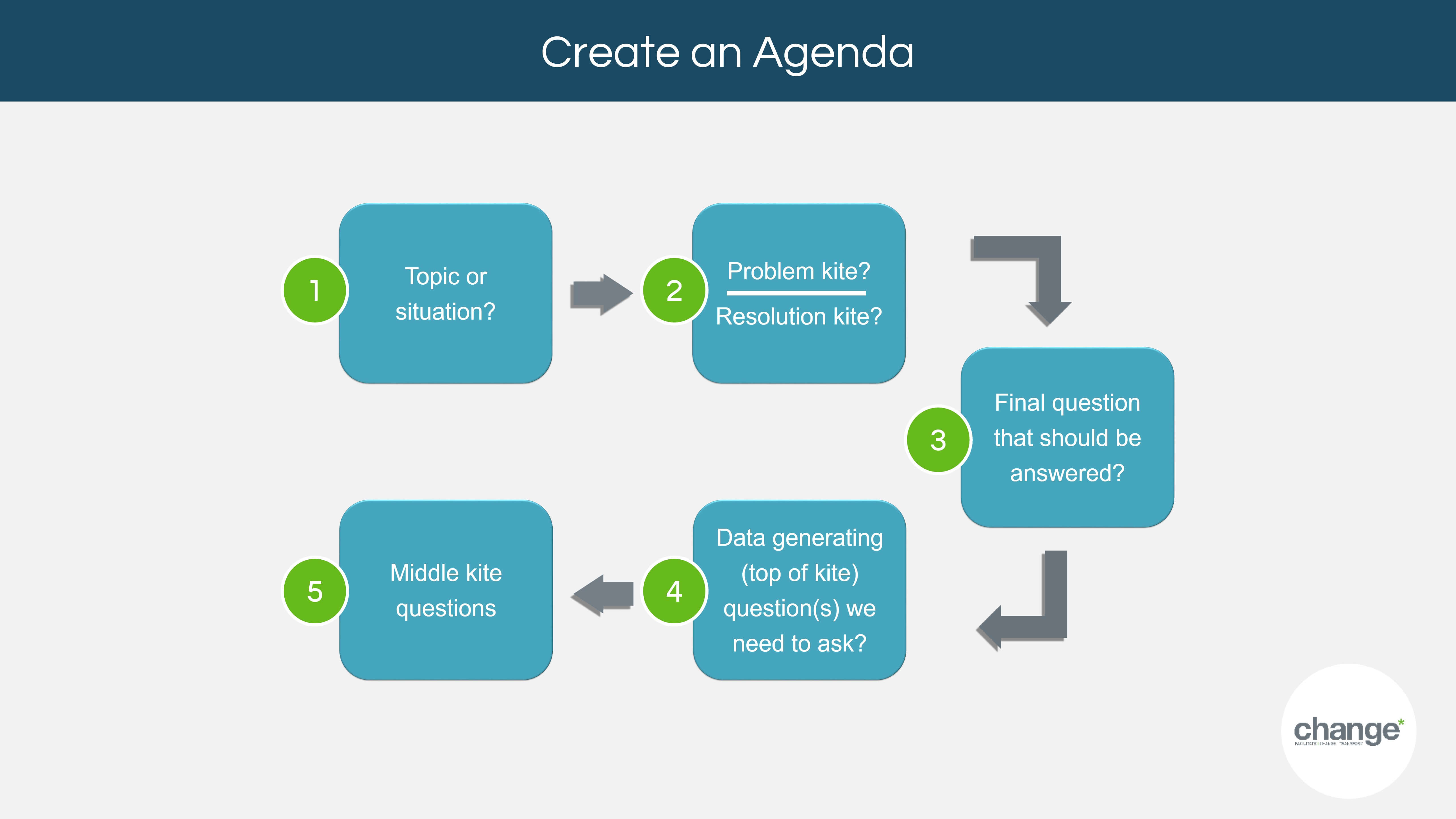How to Design Effective Meetings That Get Decisions Made
The Kite © As a Tool To Better Structure Your Meetings
In my previous article and video I spoke about the two main problems that derail business meetings. They were the “social” and “structural” problems.
In this article, I’ll explain how to address the meeting structure problem, and how to introduce the “Kite” as a tool to help you do it. Are you ready to reach collective decisions and have more effective meetings? Let’s go!
A demonstration of poor meeting structure
To begin our thinking on how to better structure business meetings that deliver effective collective decision making, please first have a look at the meeting transcript below. It’s an adaption of many un-facilitated meetings I’ve observed as part of my research, and it demonstrates various structural problems.
As a context setter, the team’s manager, Bill (the CFO) has called this meeting with the key members of the accounts department. The latest 360 feedback shows that this section seems to be poorly regarded by other departments. The feedback was circulated to the participants before the meeting.
Team Manager (Bill): Thanks guys for coming to this meeting. As you know, we just got our feedback from the survey. As you probably recall, this survey was sent to the other departments to get information on our performance in servicing them. As I’m sure you will agree, our results look pretty ordinary. We really need to do something about how our internal clients see us.
Mary: Yep we sure do. We can do better than this. We clearly need to bite the bullet and invest in some decent software so that Marketing especially can trace the progress of the invoices being paid to their clients. It’s just got to happen!
Jeffrey: Hang on Mary. That sounds a little trigger happy to me. Let’s take a little time to look at the results in some detail.
Mary: Trigger happy? I have been trying to get us to invest on some decent software for almost 2 years. This feedback makes it perfectly clear that it is now overdue for us to finally do it.
Bill: Mmm, I think we have had this conversation before, Jill what do you think?
Jill: Just scanning the feedback, it seems to me that one of the main issues our internal clients have is making sure they get their main suppliers paid on time. There are probably other themes in this data, and I think this needs more analysis.
Jeffrey: I have been looking at that. We are better with some departments than others. I’ll just pull up a spreadsheet which shows how long it has been taking us to get these invoices paid….
Rodney: Surely we are past looking at another spreadsheet. I think we all know that Marketing has the most invoices to get processed, and that we are most likely taking longest to get their suppliers paid. It seems obvious to me that this really is a problem about us not looking after Marketing well enough. We got too busy and forgot about our busiest internal client.
Bill: Yep, that sounds pretty clear. But we have previously talked about that too. Something seems to get in our way to ensure Marketing gets their invoices paid in good time. I’m not sure why…..
Mary: Frankly Bill, while you try and figure out the deep problems, the situation gets worse. Why are you so unwilling to invest in better software?
Jeffrey: Because he considers that a little more thought is required to justify a very large investment. I believe the software itself will cost in the order of $100K, with 6 months to roll it out…
Bill: I don’t want this meeting to turn into another argument about software. I think maybe we should get a couple members of the group to review the feedback and come up with some suggestions. I think this conversation should go offline now…
Rodney: Offline again? Our real problem is that everything gets taken away to some committee whose recommendations we rarely agree. As I said before, addressing the issues with Marketing would be one simple, cost effective response. This does not have to be complicated….
Jill: I’d like to be on that committee. I really want to look more closely at that feedback…..
Jeffrey: Me too, I don’t think we understand the feedback yet.
Bill: OK Jill, get a couple of others on that with you, in the meantime, the next item on the agenda is about……
I’ve shared this very meeting scenario with many groups, and some of the responses to this question are:
- ”they seem to have their own agendas”, or
- “they are not really listening to each other”, or
- “they have had that meeting before!”, or
- “what is the manager doing? Very little it would seem!”
Did you have some of the same thoughts? Me too.
At the same time, I’d like to invite you look at this transcript another way. A way that shows that each person is faithfully bringing their gift to the group, but in the absence of good meeting structure, they are clashing.
Addressing the problem
The problem may NOT be the participants, but rather a lack of meeting facilitation that provides good structure.
Let’s look more closely at the script.
You might notice that some participants are repeatedly addressing the problem, while at the same time others are trying to resolve it.
For example, the comment,
“Just looking at the feedback, it seems to me that the main issue our internal clients have is making sure they get their main suppliers paid on time”
is a statement from a team member who is investigating the problem, and wants to understand it more fully.
Alternatively, the comment,
“We clearly need to bite the bullet and invest in some decent software”
is attempting to direct the team to a resolution of the problem.
That’s right, while this team appear to be talking to each other, they are essentially on different topics, having parallel conversations.
One topic is, “what is our ‘real problem?” and the other is “what shall we do to fix this situation?’, and they are happening simultaneously.
Both of these topics need talking about, but doing it at the same time is a very tricky thing to do, and mostly does not end well.
While sometimes it might be fun to have a completely free wheeling discussion, in my experience a team’s ability to listen carefully to concurrently emerging themes in the problem and resolution space is VERY limited.
In other words, doing both at once is a more sophisticated task than most teams can manage!
So when it happens, frustration usually builds.
Neither topic gets taken to the required end point and instead, teams become frustrated in the circular and parallel nature of their conversations. And who could blame them?
And that frustration is ubiquitous in our everyday meetings. Frustration because their meeting has been inadequately structured, and it’s become a victim to our “let’s not structure our conversations, but hurry up and finish all the same” culture.
In-fact, these two conversations are dramatically more effective if one happens AFTER the other (not at the same time).
Therefore, here is THE fundamental and powerful question to bring to the conversations your team is having.
At any one moment, which “space” are we focused on?
But is the frustration in your daily, weekly or monthly meeting really that bad? If you are the manager of the team, you may not be the person to ask. My own research and experience of other practitioners/researchers that managers are unlikely to experience the same frustration with their meetings as their team members.
In other words, if you are the manager, you are very likely to underestimate the frustration in your team, or you may not even notice it at all. And not only that, even if you ask your team about their experience of your weekly meetings there is a good chance you won’t get the whole truth.
Why? Well that’s a fascinating topic, and one for a future article. In the meantime, let’s get your meeting structure sorted.
Introducing the Kite – a tool to help you structure your meetings
Now let’s have a closer look at those who are talking about the problem. They seem to be saying and asking different things.
For example, while some are asking,
“Let’s take a little time to look at the results in some detail”
others are keen to bring their analytical abilities to it,
“Just scanning the feedback, it seems to me that one of the main issues our internal clients have is making sure they get their main suppliers paid on time.
Finally, some seem to have arrived at the core problem already, as seen in their comments,
“this really is a problem about us not looking after Marketing well enough. We got too busy and forgot about our busiest internal client.”
These three comments illustrate the three parts of the work to be done in the problem space conversation. Those three parts can be visually displayed on a ‘Kite’.
Here is a breakdown of the three parts:
- the first part is the gathering of information about the problem,
- the second is the analysis of that information, and
- the final part is the decision making in connection to what the core problem(s) are.
Both the problem and resolution space have a three step “kite”, and they are shown below.
The Kite model can help you structure your meetings in a way that ensures all the meeting participants arrive at the intended decision moment at the same time.
To that end, it is helpful to imagine that your meeting will progress from the top of a Kite to the bottom throughout the meeting. And this may happen several times if multiple problems and resolutions are examined.
Gathering Data: The top of the Kite shows a widening space that represents the time in the meeting when data is being reviewed or generated.
Analysis: The bottom half of the Kite shows a space narrowing as the two sides converge. This represents the time in the meeting when the data is being analysed.
Decision-making: The final portion of the bottom of the Kite represents the time the final decisions are being made.
The problem for many un-facilitated meetings is that the participants simply gravitate to the Kite they prefer (problem or resolution) and the part of that Kite where their preferred thinking processes may take them.
Therefore, in the absence of effective meeting structure, someone will be trying to clarify the data that relates to the problem, at the same time someone else will be advocating a final decision about the solution!
As you can imagine, this frequently leads to conflict and only because the meeting was insufficiently structured! In other words, the meeting participants did not agree which ‘space’ to be in, before progressing through the Kite that would guide them through an effective decision making process.
How to use the Kite in your next meeting
Before your next meeting, set the agenda using your Kite. Then follow the below steps:
Step 1: Clarify the topic for discussion
Step 2: Decide which Kite is required – the Problem Kite or the Resolution Kite
Step 3: Clarify the Decision Making Question to be asked at the bottom of your chosen Kite
Step 4: Clarify the Data Gathering Question to be asked at the top of your chosen Kite
Step 5: Clarify the Analytical Question for the middle of your chosen Kite
The below diagram outlines the above flow for your agenda.
Conclusion
The decision making Kite is a tool that when used can help structure fantastic effective decision making meetings. Give it a try!
I’d love to hear how this works for you in your meetings and would be happy to answer any questions you place in the comments below.
JOIN OUR COMMUNITY




